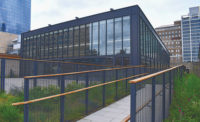ENR MidAtlantic 2018 Best Projects
Best Renovation/Restoration: Rehabilitation of Constitution Gardens -Phase I

The historic Lockkeeper’s House, built 184 years ago, originally sat at the connection of the Chesapeake and Ohio canal and the Washington City Canal.
Photos courtesy of Hensel Phelps

To begin the relocation, Hensel Phelps removed the bottom 18 in. of historic stone and elevated the structure 2 ft above its current foundation. The house’s eight windows and two doors were infilled with concrete blocks so the house could be held in compression during the move.




Rehabilitation of Constitution Gardens - Phase I
Washington, D.C.
Best Project
Owner: The Trust for the National Mall
Lead Design Firm: PWP Landscape Architecture
Preservation Architects: Davis Buckley Architects and Planners
General Contractor: Hensel Phelps
Civil Engineer: Thornton Tomasetti (Weidlinger Associates)
Structural Engineer: MCC 1200 Architectural Engineers
MEP Engineer: Henry Adams LLC
Historic Home Movers: Wolfe House & Building Movers
Subcontractors: Lorton Stone (Stone Mason); Ruppert Landscape (Landscaping & Site Concrete); Berkel & Co. (SOE & Piles); Corinthian Contractors (Earthwork & Site Utilities); John E. Kelly & Sons (Electrical); Welch & Rushe (Mechanical); Oak Grove Restoration
The first phase of the rehabilitation of Constitution Gardens in Washington, D.C., centered around relocating the historic Lockkeeper’s House, the oldest building on the National Mall. The house, built 184 years ago, originally sat at the connection of the Chesapeake and Ohio canal and the Washington City Canal. The building, which is listed on the National Register of Historic Places, features 20-in.-thick, load-bearing unreinforced fieldstone masonry walls, a shingled roof and end chimneys.
The project required moving the building 30 ft to the west for improved access. To begin the relocation, Hensel Phelps removed the bottom 18 in. of historic stone and elevated the structure 2 ft above its current foundation. Eight cross beams and 10 needle beams were used to support the house’s structure while on the hydraulic lift. The removed stones were catalogued and photographed to help guide reinstallation. Removal of the stones, which date back to about 1837, required National Park Service approval and careful documentation with preservation specialists. One judge said: “Working with the federal government isn’t always the easiest, on top of it being a historic preservation. It’s a great overall project.”
The house’s eight windows and two doors were infilled with concrete blocks so the house could be held in compression during the move. Each corner of the house was supported by steel angles with three chain collar ties.
A pathway was constructed with layers of rock and steel plates to a newly constructed basement and foundation. Dollies at each corner were used to guide the house to its new location by remote control. Once the house was atop its new foundation, the original stone was reinstalled. The entire 30-ft move took roughly 60 minutes.
Extensive repointing of historic mortar joints necessitated lab-matched color and composition. A team of 12 masons completed the repointing in a climate-controlled environment. It took 21 days for the mortar to cure properly.
Besides the exterior stones, other preserved historic components include interior window elements, roofing beams and brick from the chimneys. Behind the scenes, modern upgrades were made, including four 300-ft-deep geothermal wells for the mechanical systems and new electrical and fire-protection systems.
In the original design, the project’s stormwater was to tie into the city’s existing sanitary sewer. The team discovered that it would have to tie into existing storm lines in the middle of Constitution Avenue, which would have interrupted six lanes of traffic. Working with contractor Hensel Phelps, the team designed a new structure in one lane of Constitution Avenue that intercepted a 15-in. storm drainage pipe. The team’s civil engineers and the D.C. Dept. of Energy & Environment worked together to quickly gain approval for the revised plan. That saved time and money while reducing the impact on the public.
The Lockkeeper’s House, originally used as a site for toll collection, trade record-keeping and gate operation, functioned as an entry point of commerce for the city. Today, the relocated house serves as a new gateway to the National Mall and a digital exhibition space to support tourism and education.
Related Article: ENR MidAtlantic's 2018 Best Projects: Region’s Top Work Sets High Bar






